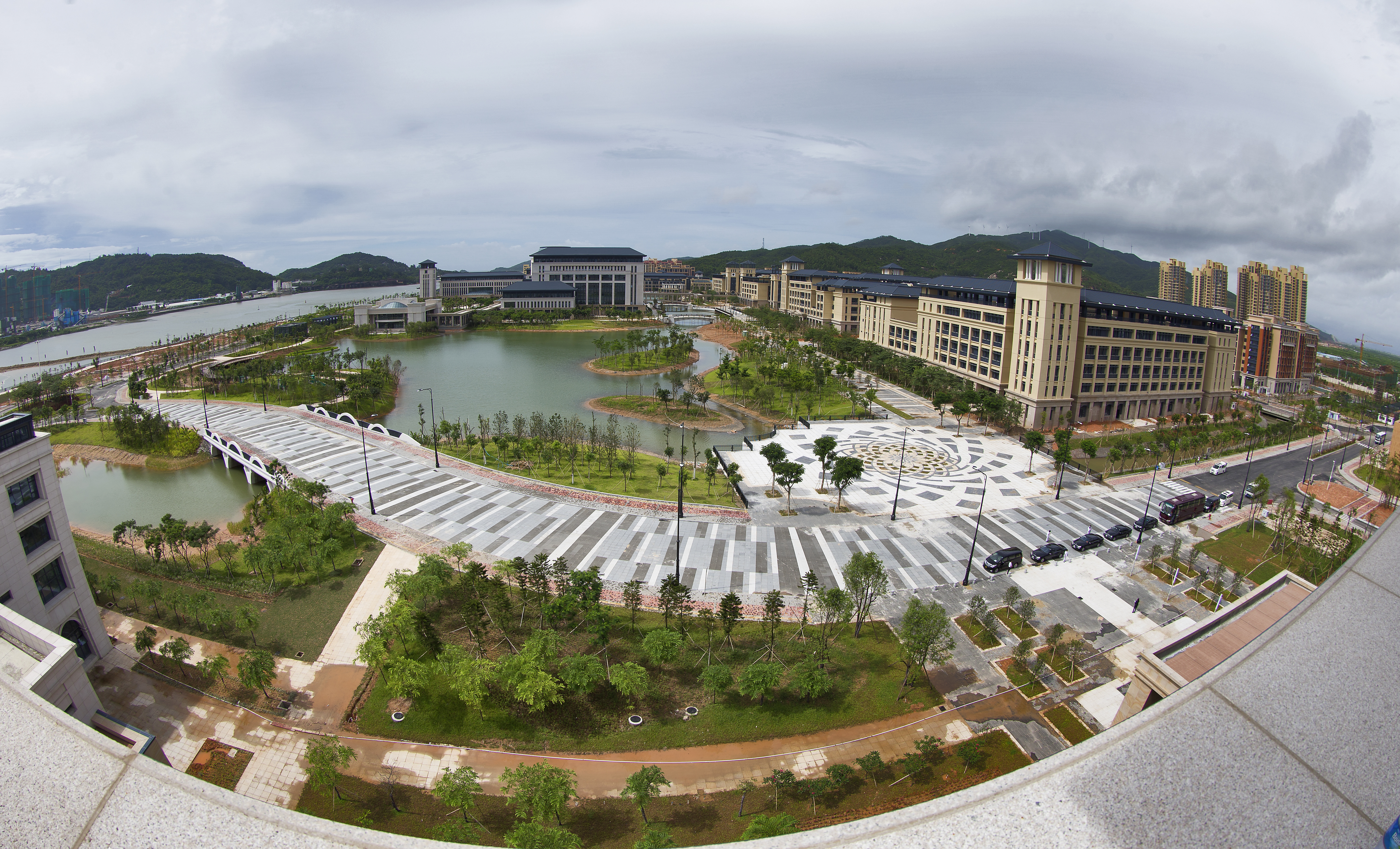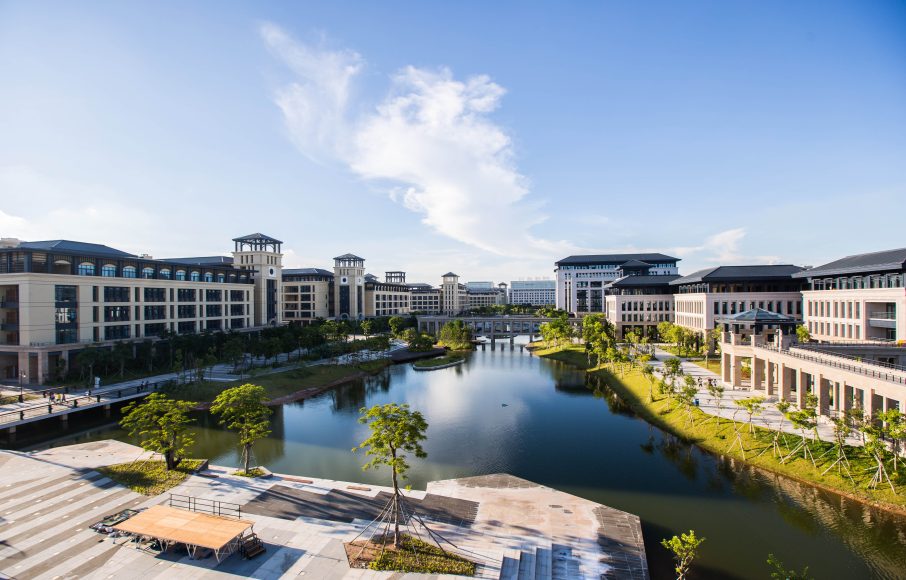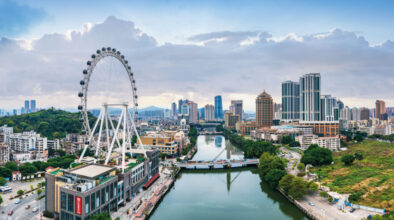When Wei Zhao took up the post of the Rector of the University of Macau in 2008, he ran a campus of 50,000 square metres with 6,600 students on a cramped site in an urban area on Taipa island.
It has been seven years now, and he looks out of his office window on the sixth floor of the main administration building over a brand new campus of 1.09 square kilometres, with 9,000 students, over 500 faculty and an annual budget of 2.2 billion patacas.
For the head of a university, it is a rare opportunity to oversee the construction of a campus with sufficient funding provided by the SAR government and corporate and individual donors.
“I feel very pleased and comfortable,” said Zhao in an interview. “The best time to enjoy the campus is between six and eight in the evening, when you can see the students jogging, cycling and doing sports; you wouldn’t have been able to see these things on the old campus.
“Of the water in our lakes and waterways, not one drop is from the tap. All is from the rain and the roofs. Of the showers, 80 per cent use water heated by solar panels. Only in the winter months, between December and February, do we use gas to heat the water.”
On the wall of his office hangs a piece of calligraphic work from Hsing Yun, one of the four great Buddhist masters in Taiwan. In January 2013, Master Hsing Yun received an honorary doctorate from the university.
In the Times Higher Education World University Rankings 2014-15, the university is ranked among the top 300 for the first time, showing its progress and momentum, especially in software and hardware development. Zhao said that UM has overtaken Hong Kong Baptist University in the rankings.
The new campus is on the east side of Hengqin Island, facing Taipa, to which it is joined by an underwater tunnel. It houses more than 15 academic complexes and over 60 independent buildings, including residential colleges and amenities.
The Wu Yee Sun Library can hold over a million books and academic journals; about seven faculties are within walking distance of each other, accessible by covered walkways. The Central Teaching Building has the capacity to hold classes for up to 3,000 students at a time. There is a purpose-built mall with restaurants and shops.
The contrast between the new campus and Taipa is striking. With giant new casino hotels being built to add to those already in place, including the Venetian, the largest building in Asia, Taipa now increasingly resembles a forest of concrete.
In contrast, the campus is full of lakes and waterways. It has 22,000 trees and 430,000 square metres of green space, accounting for more than 40 per cent of the campus area; water covers 110,000 square metres.
Innovative Solution

The University of East Asia was established in 1981 and in 1991 changed its name to University of Macau and became public. It is the only public comprehensive university in the SAR.
In January 2007, the university began to develop a 10-year strategy, including a plan to develop a campus able to hold at least 10,000 students. But there was no land for this in Macao. In May that year, the University Council discussed the possibility of building a new campus in Hengqin.
There followed two years of complex negotiations. Students and faculty did not want to move if they had to go through immigration clearance and be subject to the restrictions in Internet access in the mainland.
An innovative solution was found – the campus site in Hengqin would be under the jurisdiction of the Macao SAR and a tunnel of 1.57 km would connect it to Taipa; this is the sole point of access. This required the standing committee of the National People’s Congress in Beijing to pass a special bill to grant the land-use rights to the Macao SAR.
So now everyone can access the campus without going through immigration clearance and Internet access remains the same as before. The SAR government is paying the Zhuhai government 1.2 billion patacas for a 40-year lease that will expire on December 19, 2049.
“We are all happy that the right decision was made,” said Zhao. “My job was to listen to the concerns of the university community and to make sure that they were heard. Many people had an input. The work was done at a high speed.
“During the early negotiations with the Zhuhai government, we were offered land on the other side of the mountain, about three kilometres from the current site. But we said that we wanted a piece of land opposite Macao,” he said.
Then President Hu Jintao officiated at the ground-breaking ceremony on December 20, 2009 and the new campus was handed over to the university in 2013. It was inaugurated in November 2013 by Wang Yang, Vice Premier of the State Council. All departments, students and teaching staff started work and study on the new campus in August 2014. The construction cost was 9.8 billion patacas, all of it from the SAR government.
Moving in

Zhao said that the problems in the early stage were similar to those one would encounter when moving into a new house – some lights did not work and the water did not come out of some taps. “Problems occurred and we fixed them. Things are stable now. For the faculty, it was a life change. They faced a longer journey. We have adjusted the traffic services to meet the demand.”
Now 4,000 undergraduates, 2,500 graduates, as well as 300 faculty members and their families live on the campus. The new campus enables the university to do many things it could not do before. These include eight residential colleges, each home to about 500 undergraduate students. The residential colleges at UM follow the model of Oxford, Cambridge and Harvard. The number of the colleges will increase to 12 in the near future.
“The students live together, participate in different activities together and learn from each other,” said Zhao. “Two students share one room. Some parents offered to pay extra to get single rooms for their children, but I refused. Two in a room is a requirement. For some students, it is more comfortable than how they lived at home.
“The new campus presents the best-ever opportunity for the university to implement initiatives such as the ‘4-in-1” model. This involves discipline-specific education, general education, research and internship education, and community and peer education. We want to broaden the students’ horizons beyond their sole focus on academic studies. From the perspective of whole-person development, they not only learn knowledge in the classroom but also need to discover new knowledge and apply it in daily life in society.”
The university has seven faculties — arts and humanities, business administration, education, health sciences, law, social sciences, and science and technology. It offers 130 degree programmes.
Students from Macao

80 per cent of the undergraduate students come from Macao, 15-17 per cent from the mainland, and the rest from Hong Kong, Malaysia and elsewhere. There are very few from Portuguese-speaking countries. Zhao would like to see more students from Africa, India and North America.
“There is no legal requirement on the percentage of Macao students. We believe 80 per cent is good. It depends on availability. We have devoted a lot of resources to attract local students, with three levels of scholarships. Every year we admit about 1,200-1,300 students from Macao, and one third of them receive scholarships from us. We ask the faculty to work with local high schools to persuade their students to come here rather than go abroad.” Of the Macao graduates, 75-80 per cent choose to stay in Macao for work and the rest choose to go abroad for further studies. Non-local students are not allowed to work in Macao – except a few who are hired by local companies.
The university recruits faculty members from all over the world. They come from the mainland, Europe, Australia and Brazil, including natives of Macao who are working abroad.
The university aims to prepare students for both the Macao economy and the global economy. “Macao needs a population with mixed knowledge and not only for its immediate needs,” said Zhao. “Our population is only 600,000 but does that mean we do not need a faculty of science and technology? Our responsibility is to produce a mix of different knowledge and backgrounds. The government always supports our academic programmes and never asks us to kill a particular one.”
He believes that a high-quality institution not only should have medical and natural sciences, engineering and technology, but should also have humanities and language arts. So the university has formed an academic alliance with National Taiwan University, Hong Kong University and Beijing University, where Ph.D students of Chinese studies can study at any of the institutions.
Plans are underway to develop a design institute to offer courses such as landscape design and environmental design that will nurture talent for Macao’s creative industries.
Sufficient Financial Resources

Unlike the rectors of many universities in the west, Zhao has abundant resources. According to its annual report, the budget in the 2014 year was 2.17 billion patacas, compared to 1.79 billion in 2013 and 803 million in 2009. The SAR government provided 60-65 percent of it.
It is also blessed with many donations from individuals and corporations.
Wu Yee Sun covered half of the cost of the library named after him. Born in Shunde in 1900, Wu moved to Hong Kong in 1920 and was one of the founders of the Wing Lung Bank in 1933. He gave generously to many causes before he died in Hong Kong in 2005 at the age of 104.
“Each of the eight residential colleges has been endowed. We actively look for donors, not only for the money but to show the relationship with the community. All are connected to Macao, with family or businesses here.”
The largest single donation the university has received was US$135 million from the casino operator Steve Wynn; it went into an endowment fund which invests the money and gives the profits to the university to use. Wynn’s donation goes to the management and economy studies.
Invest in Research

The university has invested heavily in research. It has two state key labs –the State Key Laboratory of Analog and Mixed-Signal VLSI and the State Key Laboratory of Quality Research in Chinese Medicine.
The second was set up and is supervised by Professor Rui Martins, the Vice-Rector for research and a world-famous expert in micro-electronics. The laboratory researches the interface between analogue and digital, with particular emphasis on applications for mobile communication.
In 2015, it has an annual internal research budget of close to US$17 million, and more than US$10 million from the external fund.
The research into Chinese medicine is in line with the policy of the SAR government to develop this sector as a new industry. The department has 29 faculty members and several hundred graduate students.
“We invested in new laboratories in Chinese medicine and this was recognized by the Ministry of Science and Technology (in Beijing),” said Zhao. “This is exceptional in Hong Kong and Macao. Academically speaking, this is challenging and exciting.
“In the past, Chinese medicine was not treated as a science. We did not know the side effects of an herb or how to control the quality. We are using scientific methods to measure their side effects and hope to translate this into real products in a few years that are scientifically proven. A university cannot sell products, so we will transfer the technology to a company and hopefully receive a portion of its profits.”
According to the ISI Web of Science Database (as of 11 June 2015), the university published 776 world-top level publications, including books, refereed journals and conference proceedings in 2014, 3.8 times the number in 2008.
“In some areas, including microelectronics, Chinese medicine and the Internet of Things, UM ranks among the top in the Greater China region in terms of papers published in prestigious journals.”



